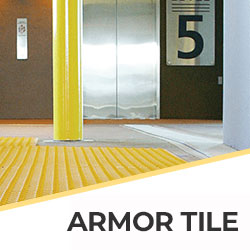









In our fast-growing society, the need for accessible and safe public spaces has become more crucial than ever. With over 5.59 million Canadians living with vision impairment or partial sight loss, it's imperative that our built environments cater to people of all abilities. This is where tactile paving solutions come into the picture.
Tactile paving, also known as detectable warning surfaces, are textured ground surface indicators that provide essential cues to pedestrians with visual impairments. Installing these specialized paved surfaces enhances accessibility and safety in public spaces.
As per the Accessibility for Ontarians with Disabilities Act (AODA), tactile paving is a mandatory accessibility solution in public spaces across Ontario. For contractors and building owners, integrating compliant tactile paving solutions demonstrates a commitment to constructing inclusive infrastructure.
This blog post will explore what tactile paving is, how it assists people with vision loss, its significance in urban planning, and how Tactile Solution’s range of code-compliant tactile products can enhance safety and accessibility.
Tactile paving uses standardized textures that pedestrians can detect through their feet or mobility canes. The raised bumps, bars, cones, or domes on tactile surfaces provide essential information to individuals with visual impairments.
Tactile paving is commonly constructed from durable materials like metal, ceramic, concrete, rubber, or composite polymers. The textures are installed on sidewalks, transit platforms, building entrances, and more. When appropriately implemented, tactile paving solutions make public realm navigation intuitive for citizens of all abilities.
For people with visual disabilities, tactile walking surface indicators transform environments by providing vital sensory information through touch. Here are some of the key benefits of tactile paving for enhanced accessibility:
In Canada, tactile paving installations must adhere to accessibility standards and building codes at the federal, provincial, and municipal levels. Key regulations include:
To ensure compliance, tactile paving solutions must fulfill dimensional, material, installation, contrast, and placement specifications per the abovementioned regulations. Failing to adhere can lead to safety risks and violation of provincial laws.
For urban planners and designers, tactile paving is indispensable for crafting inclusive public realm landscapes. Thoughtfully integrating compliant tactile walking surface indicators enhances accessibility and safety across our built environment.
Some key applications of tactile paving in urban planning include:
With proper urban integration, tactile paving provides well-connected, intuitive accessibility networks that span our public landscapes - making cities welcoming for all.
As Canada's premier accessibility solutions provider, Tactile Solution partners with urban planners, architects and contractors nationwide to integrate compliant tactile systems that transform public spaces. Our extensive range of industry-leading tactile products empowers you to enhance accessibility and safety seamlessly.
Made from durable engineered composite polymers, metals and porcelain, our tactile paving solutions are designed to deliver long-lasting performance and resist heavy foot traffic. With options for surface-mounting onto existing sidewalks or embedding directly into new concrete pours, our paving facilitates both new and legacy infrastructure conversions.
Designed for seamless integration and simple installation, our paving products help achieve both accessibility compliance and aesthetic appeal. With the choice of sizes, shapes, materials, and colors, find the ideal tactile solution to enhance any public space context.
Partner with us to make infrastructure accessible and communities inclusive for all. Discover our versatile range of compliant tactile paving products today at Tactile Solution Canada. Let's pave the path to universal access - one textured tile at a time!
A: Accessibility standards like the AODA and CSA B651 provide specific technical guidelines on tactile paving installation to ensure safety and compliance.
A: Key locations are sidewalks, building entrances, transit platforms, parks, information kiosks, road crossings, and parking lots. Tactile paving is required at grade changes, stairs, and potential hazards.
A: It warns users about hazards, guides appropriate pathfinding, provides orientation cues, and promotes safe, independent navigation for people with vision loss.
A: While especially useful for people with vision impairments, tactile paving provides helpful navigation and hazard cues to all pedestrians in public spaces.
